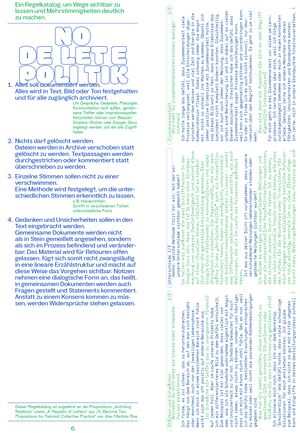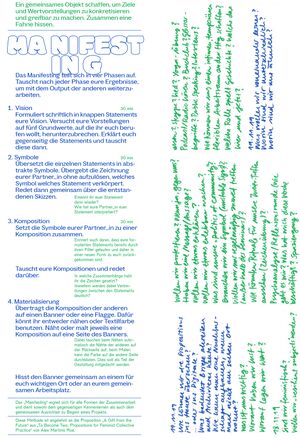Propositioning
Propositioning
Creating a framework for trying out methods together and passing them on as instructions or set of rules
- The Commitment
Decide to carry out a joint project.
- The project
Collect: What do you want to work on? What have you always wanted to try out? What do you feel like doing?
Develop a sense of what your collaboration could be about and check which interests you would like to combine. It is not about reaching an agreement but rather about individual interests coming together in a joint project.
- The format
How do you want to proceed? Decide on a format to create time and space for this project. It may help to build on references and modify already known formats.
Examples: Start a club, conduct workshops, invent a ritual, establish a pen pal relationship, start a diary, create break dates...
- Short reality check
Not all participants have the same needs, capacities and resources. Keep this in mind and integrate an awareness of them into each part of your project.
What are the different capacities, conditions, abilities, or obstacles that shape your project? For example, do you have different family commitments? What are your work contexts? What are your daily rhythms? What do you wish for in a collaboration?
- The rules
Draft a framework as clear as possible taking different variables into condition:
Time: How long should the project last? When and how often should you work on it?
Is there a certain rhythm, e.g., once a week/day? Are there certain times, e.g., in the evening, or certain moments, e.g., when you need a break?
Space: Are there meetings? Where do they take place? Do you meet in your private rooms? Outside? In a café? At your workplace? Over the phone? In a video call?
Tasks: Define specific actions, parts, or steps and integrate freedom to adapt the format individually where wished.
Consider the different capacities and needs of all participants again. Integrate a safety net and think about how your project can be harmonious and feasible even if you have to deviate from the rules.
- Reflection
Take time during and after the project to record your thoughts and experiences and to discuss them with each other.
The reflection can also be used to readjust your format.
- The Proposition
Write down the individual steps you took in the project.
What were your approaches and ways of working? What decisions were important? What would you like to pass on?
Formulate these as propositions for action in different steps, rules, or formats.
- Release
Share your proposition(s) with others: Friends, colleagues, family, community, the internet, the world.
The Asynchronous Remote Reading Club
===A framework for taking time to read and share something with another person.===
Reading
We agree that each person will find their own time slot each day to read. We will check our needs and decide whether to read or not. Unlike a usual book club, we can read different books or texts. It is up to us whether we want to focus on one book/text, create a reading list with different books/texts, or decide spontaneously from day to day.
Sharing
We agree to send a voice message to each other every day. It's up to us what we talk about. We can share thoughts about the book/text or talk about our day.
Variation:
Instead of limiting the format to books, you can also include museum visits, lectures, or workshops. For a one-person club, voice messages can also be replaced by journal writing.
Conversation (Title to be found)
The one-week-experiment “The Asynchronous Remote Reading Club” evolved from the shared feeling of hardly finding time for beautiful things, especially for reading. We both love books, but since we started our jobs—Hanna as an in-house graphic designer at a museum and Mio as a freelance designer and educator—we often lack the focus or energy to engage with the books that have been piling up next to our beds and in our living rooms. To consciously make space for reading, we came up with the Asynchronous Remote Reading Club—a simple framework that had a trial run for one week in August 2020. Besides reactivating one of our passions, the experiment also aimed at sharing something over a distance. We’ve always lived in different cities, but since we graduated from the Karlsruhe University of Art and Design, we don’t meet at school anymore and even moved to cities further away, slowly losing contact. Therefore, the project was also about reconnecting and finding other ways to spend parts of our daily lives together.
Designing a format together to try out a method and make space for a specific experience takes up a project the two of us conducted in 2019. “I don’t know. Are you sure?” searched for ways of working together that actively engage with friction and appreciate differences instead of seeking compromise. The collection of fifteen collaborative methods alongside short conversations can be downloaded via bit.ly/idk-ays (German version). An English excerpt has been published as “E for Embracing DIfferences” in “Glossary of Undisciplined Design” (Spector Books, 2021)
HM: We've decided that we wouldn't be dogmatic about our framework and that it should also be okay if we couldn't find the time to read or if we'd just manage to read a line or two. In doing so, we wanted to ensure the project wouldn't turn into another to-do on our list and to be aware of our capacities and other responsibilities. How did that work out for you?
MK: It worked really well to keep this part of our framework more open: to leave it up to us how much we would read and if we'd stick to one book or jump from one to another. I've decided to make a reading list and engage with a different book every day. Some of them I started reading already a year or two ago! Our project helped me to spark interest in some of these books again. Additionally, planning my reading sessions as a work pause felt good as I often skip breaks or eat in front of my computer. That said, it's also essential to mention that I am self-employed and the last week has been very quiet, so I probably had more capacity and flexibility than you, right?
HM: Yes, a lot was going on that week, and I was very exhausted in the evenings. Sometimes a lot of pressure built up during the day, knowing I had to pick up my book and check that box before I could completely relax. The other part of our experiment was sending voice messages back and forth to share what we read, how we made space for our experiment, or if we even found time for reading at all. In contrast to the reading part, I was pretty surprised by how easy it felt. It helped to have a concrete framework and something specific to talk about. Usually, I don't enjoy communicating extendedly via messenger or phone. Since many of my friends don't live in the same city, there are hardly any occasions for meeting in person, so I depend on these means of communication even though it is not my preferred way to keep in touch.
MK: I can relate to that feeling! In addition to sending voice messages to friends, I also have a lot of digital communication in my work. Sometimes that feels quite detached, and I am currently looking for ways to balance that more. Have you found ways to connect over the distance otherwise?
HM. It varies a lot and also depends on the other person. The nice thing about messengers is that you can also communicate through pictures. But that often remains quite shallow. Every now and then, I send a postcard or make a phone call. With some friends, that works well, and when we see each other, we can pick up where we left off. Other relationships became more complicated with the distance or got lost altogether because the needs were too different. How is it with you?
MK: During the second lockdown, in autumn 2021, I met regularly over Zoom with a friend to talk about what was on our minds in more or less formatted settings. Often, it related to our work and study situations. Sometimes we exchanged resources on specific topics, such as imposter syndrome, or shared concrete methods like time management. Some meetings were more experimental and picked up other forms to share and connect. It was incredible how we went into depth and that it was less about updating each other on the latest events. Our experiment reminded me of that.
HM: What was it that connected us in our experiment?
MK: We shared something that went beyond words. We interwove parts of our everyday life. I, for example, listened to your voicemail every morning while I drank my coffee. It wasn't a conscious decision but just became some sort of morning ritual where you—your voice and your recounting of your day—accompanied me into my day. And because you always recorded your voice messages in the evening, I felt I was with you for a part of your evening. It had something really wonderful to cross-connect these different situations, times, and spaces. How was it for you?
HM: Your messages usually came at noon, when I was at work. As I wanted to consciously create my own moment for them, I usually waited until the evening or the next morning when I had peace and focus to listen properly. It was way more relaxing than regular messages that I read in between and where I often forget to reply. Additionally, it was great to know that I don't necessarily have to pick up on things you've sent. I could instead use it more like a diary and stay within my experiences and reflections and also take in your thoughts without pressure to act on them. In general, I sensed that even though we hadn't seen each other in a long time, we had a foundation to build on. Did you feel the same way? If so, how did that become apparent to you? If not, where would you have liked it to be?
MK: When I listened to your voicemails, I imagined you sitting in your living room with the big sofas and this beautiful view out the window where you see your garden. Maybe one of your cats would sit on your lap, and you would pet them while leaving your message. A lot of memories were activated, and this certainly made me feel close. However, looking back at another voice mail experiment I did half a year ago, I think it is this particular way of using this technology that creates this kind of closeness. This diary-like way that you mentioned does a lot. So for me, our foundation has been most evident in the moments of bringing our ideas and thoughts together, in planning the project, and in reflecting on our experiences. We know each other well in these contexts, and I think we were able to look out for each other and create a framework that would allow for our different approaches and ideas.
HM: That's how I perceived it, too! And this familiarity resurfaced more quickly than I expected: The trust that we understand the other person and that we can rely on each other. It is the feeling of having a common direction, of the other's presence even when we don't meet or speak directly.

